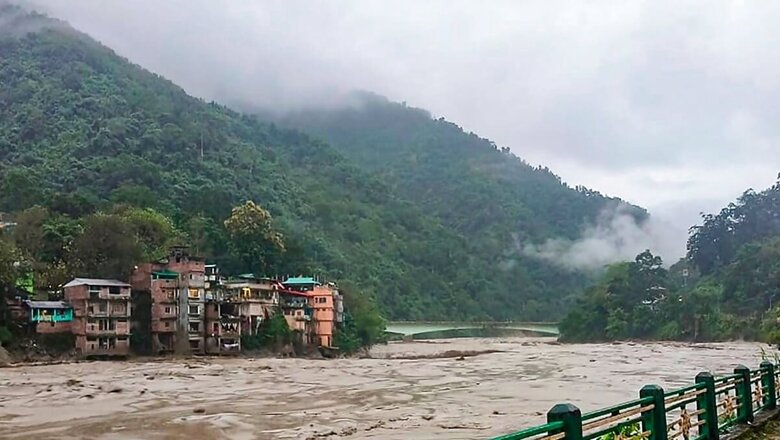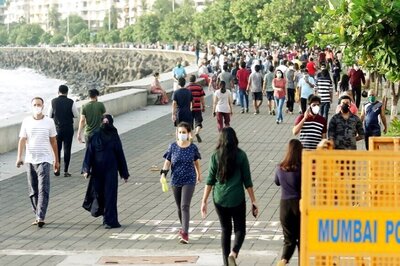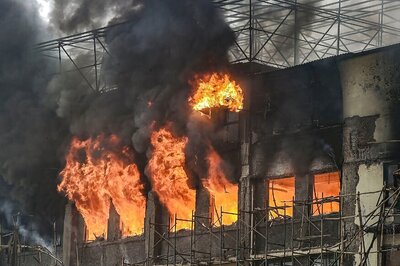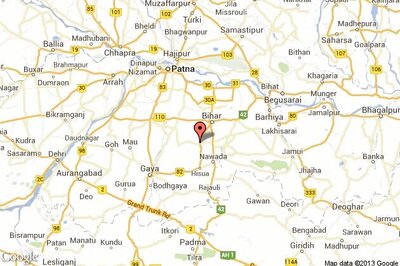
views
Scientists are exploring whether the strong earthquake that struck Nepal and the surrounding region on Tuesday is responsible for the south Lhonak lake outburst, which triggered a flash flood in the Teesta river basin in Sikkim.
The lake outburst also resulted in the breach of the Chungthang dam, which is the largest hydropower project in the state. This dam is part of the 1,200-megawatt (MW) Teesta Stage III Hydro Electric Project, in which the state government is the majority stakeholder.
Satellite images released by the Hyderabad-based National Remote Sensing Centre showed that the area of south Lhonak lake reduced by over 100 hectares compared to its size on September 17. This suggests that the lake outburst caused a flash flood in the Teesta River basin in north Sikkim.
Officials said at least eight people died and 69 more, including 22 army personnel, were missing.
“Scientists are exploring whether the earthquake that hit Nepal might be a cause of the flash floods in Sikkim. The lake was already vulnerable and covered an area of 168 hectares. Its area has now reduced to 60 hectares, indicating that about 100 hectares of water volume has breached the level,” explained a senior official at the Central Water Commission (CWC) to PTI.
The official stated that while it’s difficult to determine right now, “a cloud burst does not cause such results.” Some experts who have visited the site believe that the earthquake may have triggered the floods there.
The flood alerts were also shared with Bangladesh.
The NRSC satellite imagery revealed that the lake covered approximately 162.7 hectares. Its area increased to 167.4 hectares on September 28 but drastically reduced to 60.3 hectares.
“In this satellite data, it is evident that the lake area has significantly reduced compared to the September 17, 2023, RISAT 1A MRS satellite data,” read an NRSC report.
“The glacial lake outburst flood (GLOF) in portions of Lhonak Lake, Mangan district, which caused a rapid rise in water levels with very high velocities downstream along the Teesta River Basin in the early hours of October 4, has resulted in severe damage in Mangan, Gangtok, Pakyong, and Namchi districts,” the State Disaster Management Authority said.
“The Chungthang NHPC dam and the bridge were washed away. Two bridges at Minshithang, one bridge at Zema, and Ritchu Bridge, including the Sangkhalang bridge, were washed away,” the state government said in a statement.
The SDMA’s statement highlighted that following the lake outburst, the water level in the rivers rose at a speed of 15 meters per second.
The lake outburst caused extensive damage to life and property, including the breakdown of road networks and communication. Several vital bridges connecting to the forward border areas with Sikkim have been washed away due to the flash floods in Mangan, Gangtok, Pakyong, and Namchi districts of Sikkim, according to Sikkim’s Chief Secretary Vijay Bhushan Pathak.
Arun B Shrestha, senior climate change specialist, the International Centre for Integrated Mountain Development (ICIMOD), said: “We’re facing a devastating flash flood in the Teesta River, Sikkim. Information is fragmented, but it appears heavy rainfall from a Bay of Bengal low-pressure depression triggered the disaster. This seems like another unfortunate example of cascading hazards.” He said that the institute recorded exceedingly high precipitation, “exceeding 100 mm within the last 24 hours in the vicinity”.
Miriam Jackson, senior cryosphere specialist, ICIMOD, said: “Intense rain has led to this catastrophic situation in Sikkim where the rain has triggered a glacial lake outburst flood and damaged a dam and caused loss of life and caused further damage to roads and infrastructure. We observe that such extreme events increase in frequency as the climate continues to warm and takes us into unknown territory.” Sikkim has 733 glacial lakes, with 288 located above an altitude of 5,000 m, according to NRSC.
A study published in the journal Science Direct in 2021 stated that since these lakes are mainly situated in remote and unsettled mountain valleys, glacial lake outburst floods (GLOFs) could claim lives and damage assets tens of kilometers downstream.
GLOFs occur when lakes formed by melting glaciers suddenly burst open. This can happen due to various reasons, such as too much water accumulating in the lake or triggers like earthquakes.
When the lake bursts, it releases a massive amount of water all at once, causing flash floods downstream. These floods can be very destructive and dangerous to people and the environment in the area.
Infrastructure exposed to GLOFs in the Teesta valley suggests that many settlements and assets along the river channel at Chungthang are potentially exposed to future GLOFs. This indicates the need for a comprehensive environmental impact assessment and potential GLOF risk mitigation measures.
Some of the largest GLOF events have occurred in the Himalayas, such as the 2013 Chorabari lake outburst, known as the Kedarnath disaster in Uttarakhand. The swelling of the Jhelum river led to Kashmir floods in 2014, and Parechu river flash floods occurred in Himachal Pradesh in 2005.
The Kedarnath disaster, caused by a multi-day cloudburst between June 16-17, 2013, became India’s worst natural disaster since the 2004 Indian Ocean Tsunami. The combination of melting from the Chorabari glacier and the eruption of the Mandakini river blocked the rivers, causing major overflow. More than 5,700 people were presumed dead.
Destruction of bridges and roads trapped around 300,000 pilgrims and tourists in the valleys leading to three of the four Hindu Chota Char Dham pilgrimage sites.
A study published in the journal Nature earlier this year stated that 15 million people worldwide are exposed to potential GLOF impacts.
Populations in High Mountains Asia (HMA) are the most exposed, living closest to glacial lakes, with one million people living within 10 km of a glacial lake. More than half of the globally exposed population is found in just four countries: India, Pakistan, Peru, and China.


















Comments
0 comment